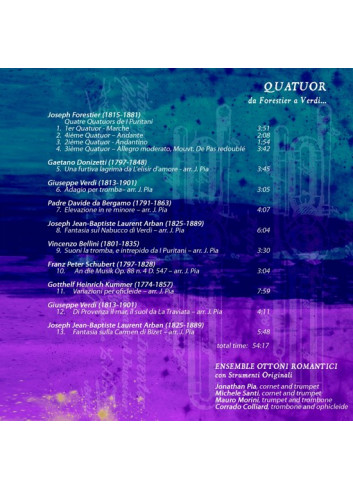

QUATUOR da Forestier a Verdi
- 1er Quatuor Marche
- 4ième Quatuor – Andante
- 2ième Quatuor Andantino
- 3ième Quatuor – Allegro moderato
- Una furtiva lagrima da L'elisir d'amore
- Adagio per tromba
- Elevazione in re minore
- Fantasia sul Nabucco di Verdi
- Suoni la tromba, e intrepido da I Puritani
- An die Musik Op. 88 n. 4 D. 547
- Variazioni per oficleide
- Di Provenza il mar, il suol da La Traviata
- Fantasia sulla Carmen di Bizet
The Ensemble Ottoni Romantici releases a CD dedied to the literature of the romantic period, recreating the 19th century brass ensemble with original instruments and exploring the roots and aesthetics of that period. The repertoire includes music by little known composers, as well as transcriptions of pieces by some of the most celebrated musicians of the 19th century. This approach contributes not only to the enrichment of the repertoire for brass instruments, but also to the rediscovery of the practice of transcription, which was widely used on pieces such as arias and romantic opera. The brass instruments were one of the favourite channel for bringing the music that was in vogue in the major european centres of musical activity. The majority of these works were conceived for solo instrument (cornet, trumpet, trombone, ophicleide) with piano accompaniment. There are also collections for brass ensembles, mostly quartets based upon famous operas of the period such as Schiltz’s “Quartets from Lucia di Lammermoor”, and Forestier’s “Quatre Quatuors de I Puritani”.
The Ensemble Ottoni Romantici releases a CD dedied to the literature of the romantic period, recreating the 19th century brass ensemble with original instruments and exploring the roots and aesthetics of that period. The repertoire includes music by little known composers, as well as transcriptions of pieces by some of the most celebrated musicians of the 19th century. This approach contributes not only to the enrichment of the repertoire for brass instruments, but also to the rediscovery of the practice of transcription, which was widely used on pieces such as arias and romantic opera. The brass instruments were one of the favourite channel for bringing the music that was in vogue in the major european centres of musical activity. The majority of these works were conceived for solo instrument (cornet, trumpet, trombone, ophicleide) with piano accompaniment. There are also collections for brass ensembles, mostly quartets based upon famous operas of the period such as Schiltz’s “Quartets from Lucia di Lammermoor”, and Forestier’s “Quatre Quatuors de I Puritani”.
Références spécifiques

- 1er Quatuor Marche
- 4ième Quatuor – Andante
- 2ième Quatuor Andantino
- 3ième Quatuor – Allegro moderato
- Una furtiva lagrima da L'elisir d'amore
- Adagio per tromba
- Elevazione in re minore
- Fantasia sul Nabucco di Verdi
- Suoni la tromba, e intrepido da I Puritani
- An die Musik Op. 88 n. 4 D. 547
- Variazioni per oficleide
- Di Provenza il mar, il suol da La Traviata
- Fantasia sulla Carmen di Bizet


